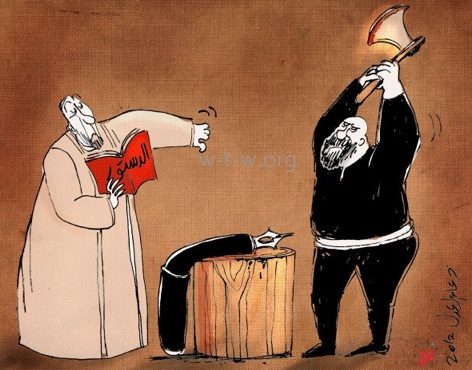Louisa Loveluck writes about cartooning in Egypt. Egypt’s cartoonists have traditionally been among society’s most searing political critics. Straddling the line between journalism and satire, they can express what others can’t. “The cartoon is a weapon,” says Anwar, the pen behind last week’s cartoon. “All artists have the gun – they just need to know when, where and whom to shoot.”
Yet his trenchant image stood out for its rarity. After three years of revolutionary tumult, and the fall of two presidents, Egypt’s subversive cartoonists are mostly taking another tack. Gone are the irreverent depictions of the leader of the day. And dissenting media outlets have been forcibly closed, or have ceased publication of their own accord, wary of voicing criticism of Egypt’s popular new leader.
“There are periods in history that are not suitable for serious criticism,” says Doaa El Adl, another cartoonist at Al-Masry Al-Youm. “You can criticize, but you must not bring down the system – these people who chant against the military regime don’t understand that the only option is the Muslim Brotherhood.”
Most media are firmly on board. On Oct. 26, leading newspaper editors convened to issue to a statement supporting “all measures taken by the state in combating terrorists and protecting national security.” A week earlier, Sisi had called on Egyptians to rally in the face of terrorism following two militant attacks on soldiers in the restive North Sinai region left 33 dead. It was the deadliest day for the Egyptian army in decades.
Egypt’s new leadership, which came to power after a military coup, casts itself as the bulwark against a political trend that indulged Islamic fundamentalism and dreamed of turning the country into a theocracy. That tilt, and the popularity of the July 2013 coup, makes cartooning a perilous profession for those who like to poke fun at those in power.
Amr Selim, an elder statesman of Cairo’s cartooning scene, says the space for dissent has shrunk. And like Ms. Adel, he sees his work as a patriotic duty: “Not everything is perfect, but Egypt must move forward,” he says.
Things changed under the interim junta that followed. Amid a febrile atmosphere, cartoonists and journalists pushed the envelope, learning by trial and error what the authorities of the day deemed acceptable. The results were popular, often spreading across social media like wildfire. Some received threats for their criticism of the army.
Pressure comes from Egypt’s feared security forces. Last month, the editor-in-chief and a reporter from Al-Masry Al-Youm’ were hauled before state security prosecutors and interrogated for fourteen hours after the paper declared it would publish investigation records into alleged fraud in the 2012 presidential election. A print run of the paper was also recently pulled over an interview it featured with an Egyptian spy.”
But just days later, the newspaper published his image of the shuttered office on the inside page. And on Thursday, it was Adel’s turn to send another shot across the bows. In her cartoon, a journalist edges along a tightrope labeled “the margin of freedom.” Below, waits the hand of authority, its fingers poised to flick and send him spinning.

